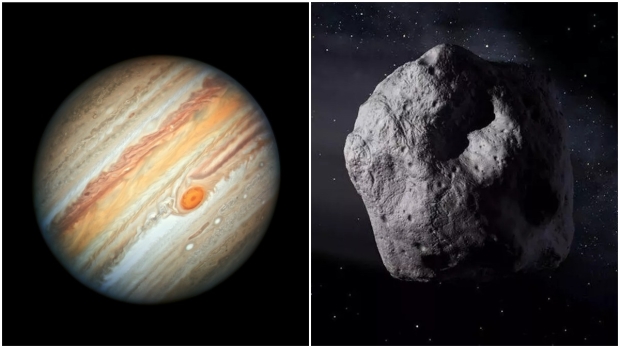Science, Space, Health & Robotics News - Page 255
Jupiter was just smacked by a space rock, impact was caught on video
Researchers from Japan have seen a space rock collide with the solar system's largest planet - Jupiter. The moments of impact were photographed and caught on video.
The researchers from Kyoto University in Japan were using the PONCOTS observation system, which is part of the Organized Autotelescopes for Serendipitous Event Survey (OASES) to view the event. According to reports, the impact happened on October 15 at around 9:24 a.m EDT and from the still images and video a white object can be seen in front of Jupiter's surface before disappearing.
The researchers verified that what they were seeing wasn't an anomaly with the telescopes they were using by asking fellow astronomers who were also looking at Jupiter at the same time. Ko Arimatsu, assistant professor at Kyoto University's Astronomical Observatory spoke to Newsweek and said, "We received another isolated detection of the same flash event from a Japanese amateur astronomer. Since the timing and the position of their detection are consistent with our detection, we have confirmed that our detection is an actual impact flash event on Jupiter."
Continue reading: Jupiter was just smacked by a space rock, impact was caught on video (full post)
Hubble captures first moments of a star's death, saw it 'in real-time'
NASA and the European Space Agency's Hubble Space Telescope bare-witnessed the first moments of a star's violent death.
In a new post on NASA's website, the space agency details that the Hubble Space Telescope has observed the first moments of the doomed star's violent ending. NASA states on its post that astronomers were given an unprecedented, comprehensive view of the violent death that will assist astronomers in creating a model that allows for accurate predictions of stars that are close to their end.
Ryan Foley of the University of California, Santa Cruz, and the leader of the team that made the discovery, said, "We used to talk about supernova work like we were crime scene investigators, where we would show up after the fact and try to figure out what happened to that star. This is a different situation, because we really know what's going on and we actually see the death in real-time."
Continue reading: Hubble captures first moments of a star's death, saw it 'in real-time' (full post)
Evidence of ancient life discovered inside a ruby, 'first time' ever
A new study published in Ore Geology Reviews has detailed the first-time discovery of evidence of ancient life being trapped inside a ruby.
Geologist Chris Yakymchuk and his team were attempting to learn more about the mineral corundum, which is the crystalline form of aluminum oxide, by examining rubies located in one of the world's oldest corundum deposits in Greenland. The team was examining samples of rubies and found that in one particular gem, there were traces of graphite, which can be an indicator for life. Upon further examination, the team found that graphite contained carbon 12, an isotope that occurs in living organisms and throughout Earth.
According to Yakymchuk, "Living matter preferentially consists of the lighter carbon atoms because they take less energy to incorporate into cells. Based on the increased amount of carbon-12 in this graphite, we concluded that the carbon atoms were once ancient life, most likely dead microorganisms such as cyanobacteria." If you are interested in reading more about this story or would like a much more in-depth analysis of the discovery, check out this link here.
Continue reading: Evidence of ancient life discovered inside a ruby, 'first time' ever (full post)
Officials release video of US volcano spewing out bubbling lava
Videos have emerged of a volcano located in the United States spewing out bubbling lava in every direction it can.
The footage is of Hawaii's Kilauea volcano and was captured on October 12. The footage showcases the volcano spewing out lava from the west vent at the summit crater. According to the United States Geological Survey Hawaiian Volcano Observatory, the vent has a spatter cone around the opening that stretches some 100 feet high. This splatter cone is protecting the area around it from eruptions. However, some larger bursts of lava have exceeded the height of the cone, spilling out onto the area around it.
At the base of the splatter cone, a small opening can be seen. This opening is feeding the lava lake below it, and according to officials, as of October 8, it's estimated that the eruption has spilled out 4.2 billion gallons of eruption volume. As for sulfur dioxide emissions, it's estimated that the volcano is releasing 2,700 tonnes per day. As for the lava lake at the base of the summit, its level has increased by 148 feet since the eruption began on September 29. All lava is confined to the summit crater.
Continue reading: Officials release video of US volcano spewing out bubbling lava (full post)
NASA releases majestic image of a 'starburst galaxy', taken by Hubble
NASA has published a new image taken by the famous Hubble Space Telescope. This time around, Hubble has snapped a photo of a distant "starburst galaxy".
NASA and the European Space Agency's Hubble Space Telescope has been in operation for multiple decades now, and despite its age, the space telescope still manages to take phenomenal images of the universe. The above image is of a distant spiral galaxy named NGC 4666, located around 80 million light-years from Earth within the constellation Virgo. NASA explains that this galaxy is currently going through an "intense episode of star formation".
Additionally, the space agency explains in its post that astronomers refer to galaxies undergoing intense episodes of star formation as "starburst galaxies". The galaxy's "starburst formation" can be attributed to its gravitation interactions with its neighbors, "including the nearby galaxy NGC 4668 and a dwarf galaxy, which is a small galaxy made up of a few billion stars." If you are interested in learning more about this truly awesome spiral galaxy, check out this link here.
Continue reading: NASA releases majestic image of a 'starburst galaxy', taken by Hubble (full post)
Here are 10 mysteries of Venus that NASA scientists are grappling with
NASA has posted a new video to the "NASA Goddard" YouTube channel that details ten mysteries of Venus that NASA researchers are still trying to work out.
In the video, the narrator explains that the surface of Venus is completely inhospitable for life, with an atmosphere at around 90 times the pressure of Earth's and a surface temperature is over 900 degrees Fahrenheit - hot enough to melt lead. But it may not have always been like that, and the space agency plans on finding out if that's true with its Deep Atmosphere Venus Investigation of Noble gases, Chemistry, and Imaging (DAVINCI) mission that is set to explore our strange sister planet.
Other mysteries that surround Venus are that its size is very similar to that of Earth's, but it's clear both planets took a very different route when it came to their evolution into what we see today. NASA's DAVINCI probe and its Venus Emissivity, Radio Science, InSAR, Topography, and Spectroscopy (VERITAS) probe are expected to answer many of the mysteries outlined in the video, and with the results from the mission, researchers will understand the evolution of our sister planet, which will add to the ever-growing collection of knowledge about how planets form.
Continue reading: Here are 10 mysteries of Venus that NASA scientists are grappling with (full post)
Officials warn monster 'bomb cyclone' is incoming, arrival date found
Officials are currently tracking a "monster" cyclone that is expected to bring heavy rainfall to certain areas across the United States.
Reports indicate that this "bomb cyclone" is expected to bring heavy rainfall and snow across the West Coast over the weekend. It's expected that this series of storms could bring as much as a foot of rainfall as well as up to three feet of snow in Sierra Nevada. Additionally, the storms have been supercharged by an atmospheric river pattern, which could lead to flash flooding and the spreading of debris from regions that have been subjected to wildfires.
According to Marty Ralph, director of the Center for Western Weather and Water Extremes at UC San Diego, "An atmospheric river marked as a category 4 or a 5 is capable of producing remarkable rainfall totals over three or more days, likely to exceed 10-15% of a typical year's precipitation in some locations." As for the categorization of a "bomb cyclone", the National Ocean Service explains that the name comes from meteorologists who observe a "midlatitude cyclone rapidly intensifies, dropping at least 24 millibars [atmospheric pressure] over 24 hours." Typically, a range in millibar change is around 10 to 15 in 24 hours.
Continue reading: Officials warn monster 'bomb cyclone' is incoming, arrival date found (full post)
Russian spy satellite caught on video, plummets to a fiery death
The American Meteor Society (AMS) has received more than 80 reports about a fireball sighting in the night sky over some US states.
According to the American Meteor Society, the sighting has been confirmed that a fireball was spotted in the night sky by people as far south as Tennessee and as far north as Michigan. The AMS confirmed the sighting to be around 12:43 a.m EDT but didn't know what the object was. It was later discovered that the fireball was the failed Russian spy satellite named Kosmos-2551.
Jonathan McDowell, an astronomer and satellite tracker that is based at the Harvard-Smithsonian Center for Astrophysics, said via Twitter that the "The fireball network confirms that the event seen in Michigan was at 0443 UTC (1243EDT) which is the exact predicted time Kosmos-2551 passed over the region, and within the re-entry time uncertainty window given by Space Force." Adding, "So I conclude that the ID with Kosmos-2551 is solid."
Continue reading: Russian spy satellite caught on video, plummets to a fiery death (full post)
NASA's next-gen spacesuits will prepare humanity for its giant leap
A new video has appeared on NASA's official YouTube channel that is essentially a trailer showcasing the space agency's next-generation spacesuits.
Through the video, NASA has announced that it will partner with the private space industry to construct brand new next-generation spacesuits that will be used for future astronauts in a plethora of missions. According to the video's description, the spacesuits will be "personalized" and will come with revolutionary upgrades in the forms of technology upgrades, better fits for astronauts, a larger range of sizes, better protection against the harsh environment of space.
Additionally, these spacesuits will enable the astronauts better mobility, allowing them to be "more nimble than ever before". The space agency says that these spacesuits will be used by astronauts aboard the International Space Station, future Artemis missions that will take humans back to the surface of the Moon, and will, most importantly, prepare NASA for "humanity's next giant leap - sending astronauts to Mars."
Continue reading: NASA's next-gen spacesuits will prepare humanity for its giant leap (full post)
World's largest underwater eruption birthed a new massive volcano
A study published in the journal Nature Geoscience has detailed the largest underwater eruption to ever occur gave birth to a skyscraper-sized volcano.
The study was published in Nature Geoscience back in late August, and details a "new" volcano that was discovered off the in the western Indian Ocean, off Madagascar. The underwater volcano emerged from the seafloor following a series of earthquakes that were detected in the region. The study looked at data from a 2014 underwater survey of the region and compared it to a 2019 survey and found that between those two dates, a volcano rose to a height of 8,465 feet below sea level.
The researchers collected geological data and found that this volcano draws magma from the deepest reservoirs ever recorded by scientists - about 34 miles underground. Nathalie Feuillet, a marine geoscientist at the Paris Institute of Earth Physics (IPGP), University of Paris, and lead author on the study, said, "The source of the magma, the reservoir, is very deep. This is the first time in volcanology that we can see such a deep reservoir at the base of the lithosphere."
Continue reading: World's largest underwater eruption birthed a new massive volcano (full post)











